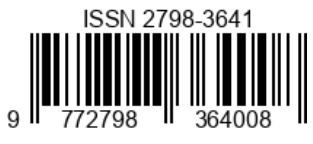ALGORITMA GENETIKA UNTUK OPTIMASI PARAMETER NILAI K PADA METODE K-NEAREST NEIGHBOR
Keywords:
Genetic Algorithm, Classification, Drugs, K-Nearest Neighbor, OptimizationAbstract
Classification is a systematic grouping of objects into certain categories based on the common characteristics they have. One of the algorithms that is often used in classification is the K-Nearest Neighbor (KNN) algorithm, because the algorithm is easy to understand and apply, can be used on data that has many classes, and is effectively used for large data. However, this algorithm also has a weaknesses in making biased K parameters, resulting in reduced level of accuracy. Therefore, in this study, optimization of K parameters was carried out using a genetic algorithm.The data used in this study is a drug dataset sourced from the Kaggle platform. The total number of these datasets is 200 data records with 150 data used for training data and 50 data used for data testing. The overall data will be classified into five categories, namely drug category A, drug B, drug C, drug X, and drug Y. The classification is based on five criteria, namely gender, age, blood pressure, cholesterol, and sodium potassium. The best accuracy results obtained from the optimized KNN classification is 85% with parameter K=1. The accuracy is the same as the KNN search results without optimization by using the K parameter from a value range of 1 to 5 which produces the best accuracy when the parameter is at K = 1.
References
Anjar Wanto, D. H. (2020). Data Mining: Algoritma dan Implementasi. Medan: Yayasan Kita Menulis.
Zadlyka, T. (2021). Optimasi Metode K-Nearest Neighbor (KNN) Menggunakan ParticleSwarm Optimization (PSO) untuk Diagnosis Penyakit Hati. Palembang : Fakultas Ilmu Komputer Universitas Sriwijaya.
Ibnu, D.L, Ardian, D.P (2017). Optimasi K-Nearest Neighbour dengan Algoritma Genetika :Jurnal Teknik Informatika.
Kukuh, W.M, Yuita, A.S., & Achmad, A. Optimasi K-Nearest Neighbour Menggunakan Particle Swarm Optimization pada Sistem Pakar untuk Monitoring Pengendalian Hama pada Tanaman Jeruk.Malang:Fakultas Ilmu Komputer Universitas Brawijaya.
Fitri, D.A , Dian, E.R., & Agus, W.W. Deteksi Penyakit Kucing dengan Menggunakan Modified K-Nearest Neighbor Teroptimasi (Studi Kasus: Puskeswan Klinik Hewan dan Satwa Sehat Kota Kediri). Malang:Fakultas Ilmu Komputer Universitas Brawijaya.
Jollyta, D., Ramadan, W., & Zarlis, M. (2020). Konsep Data Mining dan Penerapan. Sleman: Deepublish.
Novriansyah, D., & Nurcahyo, G. W. (2015). Algoritma Data Mining dan Pengujian. Sleman: Deepublish.
Han, J., Kamber, M., & Pei, J. (2012). Data Mining Concepts and Techniques. United States of America: Morgan Kaufmann.
Suyanto. (2017). Data Mining untuk klasifikasi dan klasterisasi data. Bandung: Informatika.
Arkeman, Y., Herdiyeni, Y., Hermadi, I., & Laxmi, G. F. (2014). Algoritma Genetika Tujuan Jamak (Multi-Objective Genetic Algorithms): Teori dan Aplikasinya untuk Bisnis dan Agroindustri. Bogor: IPB Press.
Anggreany, M. S. (2022, Maret Senin). Confusion Matrix. Retrieved from Binus: https://socs.binus.ac.id/2020/11/01/confusion-matrix/















